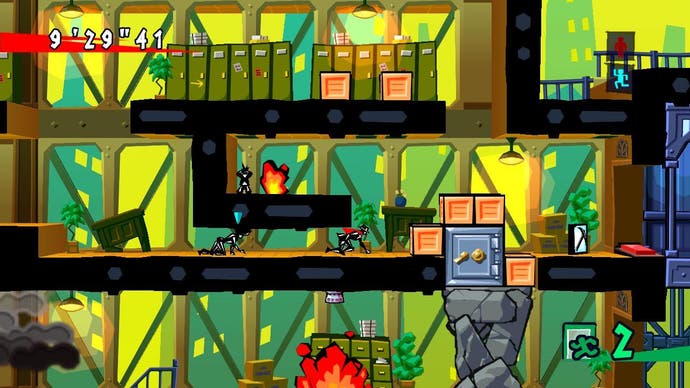Exit
The great escape.
There's something intrinsically likeable about Exit - so much so, in fact, that it's hard to approach the game without desperately wanting to like it. Whether it's the wonderfully eccentric art style, the sense of humour that suggests a mind somewhat askew, or simply the fact that it's a puzzle game that isn't another bloody variation on bloody Tetris, we're not sure. Perhaps it's a bit of all three.
Just as well, then, that Exit's beauty is somewhat more than skin deep. What we have here, in fact, is a lovely - but flawed - specimen of Xbox Live Arcade title, an endearing little puzzle game whose slip-ups are largely forgivable on account of its ready charm.
If you've already bought the PSP version, which appeared at the start of summer, then all you'll want to know is this - it's the same game, but in nice-looking high definition, and it might have downloadable content down the line. On the other hand, if Exit is new to you; well, allow me to introduce you to my new friend.
The Other Snake

My new friend is Mr ESC. Clad in a smart black suit, a yellow hat and a flowing red scarf, Mr ESC is, as his name suggests, an expert in escaping. Like an art deco painting of Snake Plissken - if Escape from New York had been directed by Oscar Wilde rather than John Carpenter - Mr ESC's task is simply to get to the exit of each of the game's 2D levels, preferably rescuing as many as possible of the stranded people scattered around the level on the way.
A freelance rescue and escape expert with a hefty caffeine addiction, Mr ESC is a remarkably expressive character, thanks to some lovely animation. He's also fairly versatile - he can climb over obstacles and up low walls, run and jump, swim for a certain amount of time, push blocks about and use a variety of pick-up items. These items include keys for locked doors, pickaxes to break weak walls, torches to illuminate dark areas and planks to create bridges over gaps.
At its most basic level, the game is a race against time to use the items provided to reach the exit of the level. Although you control Mr ESC like a platform game character, the game's focus is heavily on the puzzle aspect. After the initial training levels (there are ten of those, before you start the game proper), you'll need to seriously think out your strategy for each map, or risk suddenly finding yourself stuck on the wrong side of a block that you can't move, or trapped by a fire because you didn't think through where you were going to use your fire extinguishers.
Complicating things further are the survivors littered around the various levels. On some levels, rescuing these companions is compulsory - other levels make it optional, or give a minimum number you must rescue. Once you've reached a companion, he'll follow you around until you tell him to stop - but that's just the beginning of the delicious strife companions will cause for you.

Companions, you see, are also an intrinsic part of the game's puzzles - and of how to solve them. There are four types of companion; young adults are almost as manoeuvrable as Mr ESC himself, aside from being unable to jump or fall quite as far. Adults are big and heavy, can't jump or climb very far, but can push large, heavy blocks around single-handed.
Children are even less sprightly in the jumping and falling stakes, and need to be lifted up and down from high places - but they can scamper over fragile floors and through narrow places. Finally, patients are unable to move for themselves, and need to be carried around or pushed about on stretchers.
The left stick on your Xbox pad moves Mr ESC around. The right stick, however, moves around a cursor, which can be used to select companions and assign actions to them. Click a companion (just click in on the stick to do this), and then click somewhere on the screen, and they'll try to move there. Click a button and they'll press it, a door and they'll open it, a block and they'll shove it - they can even use pick-up items, just like Mr ESC can.
Suddenly, there's a compulsive, Lemmings-like flavour to the levels. Your companions are a team, and you need to co-ordinate them - pushing blocks, standing on floor switches, grabbing pick-ups - to get everyone to the exit door. The options available to you, and the complexity of the puzzles, ratchet up a notch. So does your smug satisfaction when all the pieces of a tricky puzzle that's been bothering you for ages suddenly fall together in your brain; "I love it when a plan comes together", you might sigh to yourself as you watch your new-found pals stream out the exit door, lighting an imaginary cigar.


